Lockheed F-117A Nighthawk. Unobtrusive tactical strike aircraft
The Lockheed F-117 aircraft became the winner in the competition of secret ("black") experimental stealth technology projects (XST - Experimental Stealth Technology) 1975-76. Equipped with General Electric (CJ610) General Electric turbojet engines, the first XST aircraft first flew in December 1977 from Groom Lake Base in Nevada. Two reduced prototypes of the aircraft were created for testing various variants of the experimental technology. Although both aircraft in 1978 and 1980. crashed, promising test results led to the development of two experienced full-scale YF-117A-LO machines, followed by the 57 F-117A production aircraft. The F-117А aircraft was declared operational in 1983, but to maintain the secrecy of the program, the plane took off only at night from a secret base in Tonopah. Only at the end of 1989, when the program was finally finally declassified, did the aircraft begin its flights during the daytime. F-117A, eloquently nicknamed the "Woblin Goblin" ("Wobblin Goblin"), more consistent with the nickname of their pilots "Black Jet" ("Black Jet"), and officially called the Night Hawk (Night Hawk). The first of these vehicles was used in December 1989 in one of the phases of the Just Koz operation carried out by the United States to transport Panamanian General Manuel Noriega. The next action was to participate in the conflict in the Persian Gulf, when one of these aircraft struck the first bombing in Operation Desert Storm on January 17 1991.
The F-117 is a specialized tactical strike aircraft designed primarily for nighttime high-precision attacks of particularly important targets during autonomous single sorties. It can also be used for tactical electronic intelligence of areas covered by enemy air defenses. F-117 is radically different from previous generations of machines. First, conventional rocket-bomb weapons gave way to high-precision arms. Secondly, the survival rate in the zone of the air defense is provided not so much by booking as by stealth of the flight.
F-117, which soared for the first time in 1981, was kept secret for a long time, because for the first time a new low-reflective form was used on it, and its main secret - the external lines. And only 21 on April 1990 was held its first public demonstration.
The low visibility of the F-117 allows the aircraft to fly over the territory covered by enemy air defense systems at an elevated height. This improves the pilot’s awareness of the tactical situation, facilitates the search for ground targets at long range and provides a more steep trajectory of bombs, and this increases the accuracy of bombing and increases the penetration capability of ammunition. The ability to fly at an extremely low altitude also increases the efficiency of laser illumination of the target for its own guided bombs. According to the testimony of persons who saw flights in 1990, the F-117A usually performs a cruise flight at an altitude of 6100 — 7600 m, then decreases to an altitude of 600 — 1525 m to increase the accuracy of bombing. It is produced from level flight, and its accuracy is about 1 m.
F-117 - aircraft with low wing, V-about-different tail and wing air intakes of engines. Widely used facet forms, which provide the main share (90%) of ESR reduction. First of all, this refers to the fuselage, which has an unusual pyramidal configuration. The cab canopy, which opens upwards, is made in the form of a one-piece construction; five glazing panels have a multilayer electrically conductive gold-bearing coating to prevent X-ray exposure of the inside cabin equipment and pilot equipment. The wing of a large sweep, trapezoidal, with beveled faceted ends, has a two-spar design.
Single cabin with an overview just ahead. Behind it, on top of the fuselage, there is a receiver of the in-flight refueling system, which is illuminated at night with the help of a headlight located in a ledge on top of the cockpit. The aircraft is unstable in pitch and yaw, and therefore uses a complex system of artificial stability. With xnumx; according to the OSPR program, an automatic thrust is installed. The air signal system has four PSTs on facet shaped rods in the nose of the machine. Sensors of attack angle retractable. Autopilot provides flight on a programmed route. Automatic traction allows the aircraft to reach the line of use of weapons with an accuracy of a few seconds. An optoelectronic navigation, detection and tracking system is also used.
The first large-scale operations using F-117 unfolded during the war with Iraq in 1991. The planes completed the 1271 take off and dropped the 2000 with laser-guided bombs. Lieutenant-General Ch. Gorner, commander of the Air Force of the multinational force in the Persian Gulf zone, said that the inconspicuous F-117A and B-2 aircraft would be indispensable in future local conflicts.
Since the Second World War, radar has become the primary means of detecting aircraft, which has so far not been equal in range and all-weather use. Almost simultaneously with the first radar, electronic countermeasure (REB) devices appeared, interfering with their work. The same period includes the first attempts to reduce the radar visibility of military equipment. So, in 1944, the Germans began to cover snorkels (devices for operating diesel engines under water) and the periscopes of their submarines with radio-absorbing materials (RPM). According to some reports, one of the first aircraft was created in Germany in 1945, on which RPM was supposed to be used - the Horten fighter jet No.IX (Gota) Go.229. On the serial samples of this “flying wing” it was planned to use plywood lining, impregnated with a special adhesive composition containing charcoal and sawdust. The fascist Germany’s emergency defense program included the production of 20 machines of this kind, but the crash of a single prototype and the collapse of the Third Reich interrupted these works.
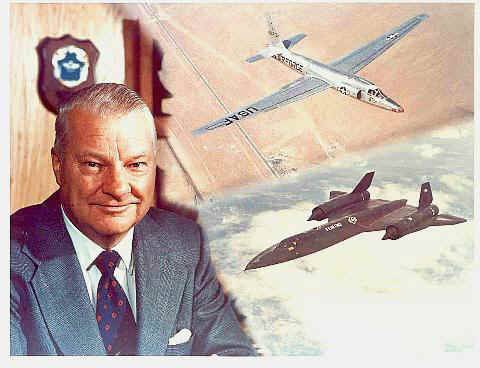 "Kelly" Johnson (Clarencel "Kelly" Jonson)
"Kelly" Johnson (Clarencel "Kelly" Jonson)In the first post-war years aviation developed at such a rapid pace that radar technology could not keep up with them, and the task of reducing the radar visibility of aircraft became less urgent. However, certain work in this direction was still underway. Thus, when designing the high-altitude Lockheed U-2 reconnaissance aircraft, its creator, the outstanding American aircraft designer Kelly Jonson, sought to minimize the size of the machine, making it less noticeable to enemy radars. In the USSR, studies were conducted to reduce radar signature through the use of special radar absorbing structures and materials. In particular, V.M. Myasishchev Design Bureau considered ways to reduce the effective dispersion surface (EPR) of a strategic ZM bomber.
By the end of 1950's With the advent of anti-aircraft missile systems in the USSR and the USA, equipped with powerful radars and high-altitude rockets, the issue of reducing the radar visibility of aircraft re-acquired relevance. After all, the main means of avoiding detection by the enemy locators was then to go to small and extremely small heights, and this led to excessive fuel consumption, increased crew fatigue and reduced combat capabilities in general. This explains the key idea of a low-impact attack aircraft: it must fly over the territory covered by air defense at medium and high altitude. This improves crew awareness of the tactical situation, facilitates the search for ground targets at long range and provides a more steep trajectory for the fall of bombs, which increases the accuracy of bombing and increases the penetrating ability of ammunition. The possibility of flying at medium altitude also increases the efficiency of the laser illumination of the target with its own guided weapons (when bombing from low altitudes, the rapid angular movement of the aircraft relative to the target, as well as its shading by the folds of the terrain, makes laser illumination difficult).
The first major attempt to reduce the EPR was the program of the high-altitude supersonic reconnaissance "Lockheed" SR-71, developed under the guidance of the same Johnson. The layout of this aircraft was determined mainly by aerodynamic requirements, but its features (cross-sectional shape of the fuselage and engine nacelles, their smooth conjugation with the wing, small keels deflected inside) also contributed to a decrease in the EPR machine. The company also developed a radio-absorbing spike-shaped internal structure with plastic honeycomb filler and applied it to the side overhangs, toes of the wing and elevons of the original version of this aircraft, designated as A-12. On the basis of the latter, the SR-71 was created, which first rose in the air of 22 in December of 1964. His radio-absorbing material was retained in the design of the wing socks and elevons. SR-71 was coated with a special paint with a high heat-emitting ability, which reduced the temperature of the skin in cruising altitude flight. Made on a ferrite basis, it reduced the aircraft’s X-ray radar visibility due to a more uniform reflection of electromagnetic waves. The EPR of the A-12 and SR-71 aircraft was significantly less than that of the U-2, and the D-21 developed later by the RPV (launched from the SR-71 and the B-52 bomber) had even less visibility. Later versions of U-2 (U-2R and TR-1) were also coated with ferrite paint.
SR-71 and U-2 are usually referred to the first generation of inconspicuous airplanes, the F-117A is considered the second representative. Its creation was preceded by long-term research and development (R & D), which was conducted in the USA with 1965. The stimulus for them was the appearance in the Soviet Union of the C-75 and C-125 air defense systems, which demonstrated unexpectedly high levels in Vietnam and the Middle East. efficiency. The hopes of the Americans for the on-board equipment of the REP were not justified - the air defense system was quickly improved and, in addition, the containers with the equipment "ate" some of the combat load of the aircraft. In 1972-73 in the United States, the Eagle, a four-seat civilian piston aircraft built by Windeker, was tested in plastic, and its further development was an experienced YE-5A, which had a fiberglass skin and an internal structure in which RPMs were used. The tests were successful, and in 1973, the US Air Force, in conjunction with the Defense Advanced Research Projects Agency (DARPA) Office, launched a secret in-depth research project aimed at creating a low-profile jet aircraft. Leading aviation concerns were sent to a special task, to which Boeing, Grumman, LTV, McDonnell-Douglas and Northrop responded.
Lockheed did not make it to the number of companies that had received the task, because during the previous 10 years they did not deal with fighters. But she nevertheless submitted her initiative proposal to DARPA, which, along with the project of the Northrop company, was chosen in November 1975 for further
XST aircraft (experimental Stealth Technology - experimental technique of low visibility). All further work on the "stealth" at the company "Lockheed" entrusted the Office for Advanced Development, located in the city of Palmdale, pc. California and semi-officially called the "Skunk Works". It was there that SR-71 and U-2 were previously created.
The technical task for the XST aircraft imposed strict requirements, first of all, on the value of its EPR. The analysis showed that the use of RPM alone and individual “barely noticeable” structural elements will not be possible to get along, fundamentally new solutions are required. The real solution was the widespread use of low-reflective forms. If earlier the aircraft’s contours were determined mainly by aerodynamics, now it had to recede into the background, and the dominant position in the development of the airframe configuration should have been given a decrease in its reflectivity. By that time, the strongest reflectors of electromagnetic energy were already known. These are the so-called mirror (brilliant) points that reflect the energy exactly in the direction from which the wave came, the joints of the surfaces, acting as corner reflectors, as well as the sharp edges of the bearing surfaces of the aircraft. Thus, the low reflecting configuration of the airframe should have been distinguished by an integral arrangement with a minimum number of edges and the absence of protruding elements. To do this, it was necessary to ensure a smooth conjugation of the wing and the fuselage, inside which the engines and target load should be placed, to eliminate vertical flat surfaces or to minimize their size (these are the strongest onboard reflectors, since the aircraft is irradiated with ground-based radars ), and the keels, if they are saved, deflect from the vertical, prevent direct radar exposure of engine compressors by using curved air intakes, etc.
Generally speaking, the “flying wing” scheme with traditionally smooth contours, which, in addition to a low-reflective configuration, is characterized by large internal volumes to accommodate engines and loads, meets these requirements to the greatest extent. In the USA, a small EPR of such a layout was first confirmed by the late 1940s when the Northrop bomber YB-49 was irradiated by the coastal radar of an air defense system located south of San Francisco. Later in the course of NATO maneuvers, the Americans noted the complexity of the radar tracking of another “flying wing” - the British Vulcan bomber, which in size was not inferior to B-47, but had several times less powerful reflected momentum.
It was possible to assume that the scheme close to Vulcan would be chosen by the developers of the XST aircraft, especially since the traditional disadvantage of such a layout — insufficient longitudinal stability — was eliminated by the distance control systems that had appeared by that time. However, the magnitude of the EPR of the aircraft, in addition to the geometric shape and electromagnetic properties of its surface, is influenced by the ratio of the size of the aircraft and the wavelength of the irradiating radar, as well as the angle of exposure. This makes it difficult to determine the optimal shape of the surface of complex curvature for the “flying wing”. The limited capabilities of computers of the seventies and the complexity of mathematical modeling of EPR did not allow solving such a problem. It was much easier than for surfaces of complex curvature, it turned out to determine the dependence of EPR on the irradiation angle for a combination of flat surfaces. As a result, Lockheed and Northrop in their XST aircraft projects decided to apply a scheme close to the tailless one with the so-called faceted (multi-faceted) hull shape. This configuration does not eliminate the brilliant points, but with a certain orientation of flat surfaces and edges, it makes it possible to combine the angles of intense reflection from several structural elements, thus reducing their number and deriving from the sectors of the most probable directions of irradiation. This means that in these directions, the facet shape provides a significant reduction in the level of the reflected signal, and in the entire wavelength range of the irradiating radar. That is, the plane becomes almost invisible for the calculation of air defense radars.
The first pancake
The XST projects of both firms were close. In addition to the facet-shaped hull, both aircraft had a large swept wing and two-fin plumage with inward-tilted keels for shielding the engines' engine nozzles. The main difference was in the location of the air intakes: Northrop offered one dorsal, located immediately behind the pilot's cabin, Lockheed - two lateral ones. At the first stage of the XST competition program, firms created special models on the 1 / 3 scale to evaluate the ESR. Their tests in anechoic chambers began in 1976, and in the middle of the same year, Lockheed won the competition, receiving a contract to build two experimental planes under the program “Hev Blue” (Have Blue can be translated as “fraudulent task, fraudulent an object"). According to Lokhidovskiy engineer A.Braun, the success of his company was greatly promoted by the use of Soviet technical literature and, above all, the theoretical work of P. Ufimtsev, an employee of the Institute of Radio Engineering and Electronics of the USSR Academy of Sciences. An article by this physicist on computational methods for determining EPR, published in 1962 in a short run departmental journal, was translated into English in 1971 and used by Lockheed in developing the Echo program for calculating the EPR of bodies of various configurations. As the Americans themselves write, it allowed the 30-40% to reduce the cost of developing the XST aircraft, and later the F-117. Tests in the chambers made it possible to clarify the configuration of the aircraft, developed on the basis of only calculations under the Echo program. Further, purging took place in low and high-speed wind tunnels with a volume of 1920 hours. Then Lockheed manufactured a full-scale radar model of the aircraft, which allowed to finally work out the details of the design and in a short time to build two flight specimens.
The experimental “Blue Blue” was a small (length with nose bar 14,4 m) subsonic single aircraft equipped with two General Electric J85-GE-4A engines taken from the North American T-2B training aircraft. The sweep angle of the leading edge of its almost delta wing is 72,3 °. The plane had neither flaps, nor air brakes, since they inevitably increased the ESR. The only control surfaces were simple elevons and two full turn, piled up inside the keel. The airframe is mainly aluminum, using steel and titanium in the most heat-stressed components. The pilot piloted the plane with the help of a side grip and ordinary pedals, the signals from which were perceived by the electric remote control system, which, by the way, had no mechanical duplication. The weight of the machine during the tests varied within 4200-5680 kg, of which up to 1600 kg was fuel.
The first launch of “Hav Blue” took place on November 4 1977 on the Skunk Works site, adjacent to the airport of Berban. To protect the secret product from prying eyes, it was placed between two trailers, pulling over a camouflage net, and the engine races were performed at night when the airport was closing. Then the plane was disassembled and 16 November aboard the C-5A was taken to the flight test site - to the secret Groom Lake base in Nevada. 1 December 1977 Test Pilot Bill Park lifted the first “Heav Blue” into the sky, designed to study the characteristics of stability and controllability. The 36 of successful flights took place, but 4 was 1978 in May while landing at a high vertical speed, the aircraft hit the runway surface severely, and as a result, the right landing gear was stuck in the half-mounted position. The pilot tried to shake it out three times by applying the left wheel to the strip, but to no avail. Then Park gained altitude 3000 m, developed all the fuel and catapulted. The second copy of the aircraft, designed specifically to study the characteristics of visibility, took off on July 20 and over the next 12 months completed the 52 flight, completing the entire test program. Their final phase included a “game” with a real air defense, when the plane was tried to be detected by all available means. “Hev Blue” demonstrated a really low visibility in the radar, infrared and acoustic ranges, proving the practical possibility of creating a low-profile combat aircraft.
Invisible in battle
F-117A was created to solve "special" tasks, primarily in the initial stages of an armed conflict. The Americans carefully studied the experience of the Israelis who managed to paralyze the Egyptian air defense system in the 1967 war with powerful, well-calculated blows and clear the sky for their aircraft. They also took into account the Soviet experience of 1968, when the massive use of airborne reparatory equipment, especially the jammers Tu-16, practically deprived Czechoslovakia of a very powerful air defense system, which made it possible to land large airborne troops in Prague without any obstacles. It was concluded that it was necessary to have a special anti-aircraft breaker aircraft in the armed forces, capable of paralyzing the enemy in a short time, striking its “nerve nodes” (of course, covered with the most powerful means of defense). Airplanes of this designation have received the name “silver bullet” in the USA (as is known, only a bullet cast from silver can kill a vampire). In the first hours of the big war, the main targets of Nighthawk were to be headquarters, communication centers, air defense infrastructure, special ammunition depots and their means of delivery. However, more exotic tasks were set before the F-117A. In particular, in accordance with the secret plan “Downshift-02”, aircraft of this type were to attack one of the dachas of the General Secretary of the Central Committee of the CPSU on the Black Sea coast, which is within the reach of tactical aviation, based in Turkey.
Having at its disposal such a superplane as at the beginning of the 1980-ies. F-117A seemed, the American command was in a well-known position of life, when I wanted to use it, and prickly, and my mother (in the sense of Congress) does not order. For the first time, F-117A was supposed to be used “in action” in October of 1983, those. even before the official achievement of operational readiness of the 4450 group. They were to take part in the attack on the terrorist camps in southern Lebanon. According to various sources, from 5 to 7 aircraft received weapons, and the coordinates of the targets were entered into the onboard inertial systems. However, US Secretary of Defense C. Weinberger for 45 minutes before departure to the Middle East canceled this order.
The same happened in 1986, when planning a raid on the residence of Libyan leader Muammar Gaddafi. It was assumed that the heavy military transport C-5 will transfer several "stealth" from Tonopah to the US Air Force Rota air base in Spain. Having penetrated into the airspace of Tripoli, covered with highly sophisticated air defense systems (including the C-200), several "Nighthrow" were to strike with a corrected bombs at the colonel's villa. However, the chairman of the Joint Chiefs of Staff W. Crowe spoke out categorically against this plan, which was lobbied by the Air Force Command interested in checking its most modern weapons. He stated that the "stelah" technique is too great a value to put at risk. " As a result, a blow to Tripoli 14 on April 1986 g, was struck by F-111 aircraft. Having lost two cars, the Americans did not achieve the main goal of the operation - the physical elimination of the Libyan leader.
For the first time, F-117А were used in 21 December 1989 hostilities as part of Operation Just Goat (Just Cause is a fair cause) - American intervention in Panama. Two Nighthawks dropped one GBU-27 907 kg bombs each with laser-guided guns at the barracks of the Panamanian National Guard in Rio Hato, where the President of the country Noriega was supposed to be. The press service of the US Department of Defense reported that “the operation was successful,” the bombs with jewelry accuracy hit the pre-selected targets - sections of the terrain that are located at a distance from the barracks, guaranteeing destruction, but at the same time, can cause panic among the Panamanian soldiers. Indeed, the guardsmen jumped out of the barracks in their underwear, however, as it turned out later, it was planned to get into the buildings. The bombs went down with a large deviation from the targets due to adverse weather conditions and pilot errors. Of course, the air defense of Panama, which did not even have a radar, did not pose a serious threat to American aviation, and the only reason for F-117A’s participation in this operation was still the same desire to test it in combat, and also to facilitate (by creating a favorable PR) US Congress funding another program for the inconspicuous B-2A bomber aircraft.
The first large-scale operations using the F-117A took place during the war with Iraq in January-March 1991. However, for the stealth crews, this war began long before the first bombings in Baghdad — 19 August 1990, when the “night stalkers” of 415th TFS left their permanent base and headed to Saudi Arabia. The 18 Nighthawk squadron performed a non-stop 14,5 hour flight with refueling from the nine accompanying KS-10. The Khamis Masheit airbase in the south-west of the country, located on a desert plateau at an altitude of more than 2000, has become a new home for the next six months. This airfield is more than 1750 km away from Baghdad, and it was chosen because Iraqi missiles “ earth-land. " With the advent of the secret aircraft in Khamis Masheyte, unprecedented security measures were taken and the regime was tightened to the limit, providing the pilots of the 415 squadron with ideal conditions for preparing for war than they had been working hard for 5 months.
Training flights were performed exclusively at night in the mode of maximum autonomy and secrecy. Particular attention was paid to the development of refueling in the air with full radio silence. They flew mainly within the borders of Saudi Arabia, only in some cases approached the Iraqi border to check the reaction of Hussein’s air defense. Stealths were never discovered, as evidenced by the continued operation of Iraqi radars (when an ordinary plane flew up to the border, the air defense immediately "lifted its head"). As acknowledged by the pilots of the squadron, their invisibility became an important moral factor, which added courage to them during night raids on enemy territory. The success of training flights prompted the American command to increase the number of F-117A in the region. In December, 1990 from the NNXX 18th TFS 416 XNUMX arrived at the profit base.
And it was midnight from 16 to 17 in January 1991 - the high point of the F-117A, when the first group of 10 “Nighthocks” of the 415 squadron, each carrying two 907-kg adjustable bombs, flew up to strike the first blows in a new war. Neither before nor after the events of that night did the crews of the one hundred and seventeenth achieve such significant successes. A member of that raid, Mr. Donaldson (call sign “321 Bandit”), recalls: “We did everything with full radio silence, focusing solely on time. Right now we have to start the engines, now get out of the shelter, start the run, etc. At the calculated moment, we met tankers 10, which took off from the Saudi Riyadh base, and completed refueling. The general system flew to the Iraqi border, then divided and each went to his goal. We did everything so that we could not be detected, turned off all the lights and removed the radio antennas. We could not say a word to our comrades and could not hear if anyone wanted to give us a message. We followed the route carefully watching the time. The first bombs dropped a pair, led by Mr. Fist (“261 Bandit”), to the Iraqi interceptor and tactical missile control center southwest of Baghdad. Due to the precise coordination of our actions in time in the following minutes, most of the planned targets were taken by surprise and amazed, including The 112-meter tower in the center of Baghdad is the key to the entire control system of the armed forces. This most important goal was destroyed by Mr. Kerdevid ("284 Bandit"). "
As soon as the first explosions thundered in Baghdad, all ground-based air defense systems, especially artillery, opened indiscriminate fire on the night sky, trying to hit targets that were invisible to them and which by that time had already formed the opposite course. For their unconditional pictoriality, this moment was particularly fond of artists: on most of the paintings depicting F-117A, the plot is one - fireworks of fiery trails in the black southern sky, silhouettes of mosques against the backdrop of fires and the shadow of mysterious, almost alien "stealth" dissolved in mist.
The list of objects damaged by the first group includes two command posts of the air defense sectors, the Air Force headquarters in Baghdad, the combined command and control center in Al Taji, and the seat of government. The second wave of the F-117A (3 machines from 415 and 9 from the 416 squadron) hit the air force headquarters, air defense command posts, as well as telephone, television and radio stations in Baghdad, at the center of satellite communications. “These attacks have blinded the Iraqis,” continues the 321 Bandit, “and they were unable to detect in time the attack of conventional aircraft that followed us. Air defense was completely disorganized. We saw on the indicators in our cabins how the Iraqi MiG-29 flew around us. But they were blind, could not detect us and execute the capture. ”
During the first day, similar 5,5-hour raids made all 36 "Night Hocks", of which 24 were in the air only in the dark, and 12 - partially in the light, taking off after 17 h local time. Most of the strikes were carried out by single planes, and only three ground targets were attacked by pairs, in these cases, driven by an infrared system could evaluate the results of the lead bombing and correct their attack. As a rule, the F-117A operated autonomously, without the involvement of REP aircraft, since jamming could have attracted the attention of the enemy. In general, in the course of the war, in order to increase the secrecy, operations of the “stealth” were planned so that the closest Allied aircraft was at a distance of at least 160 km from them. Only in some cases, one hundred and seventeenth interacted with EF-111 and F-4G.
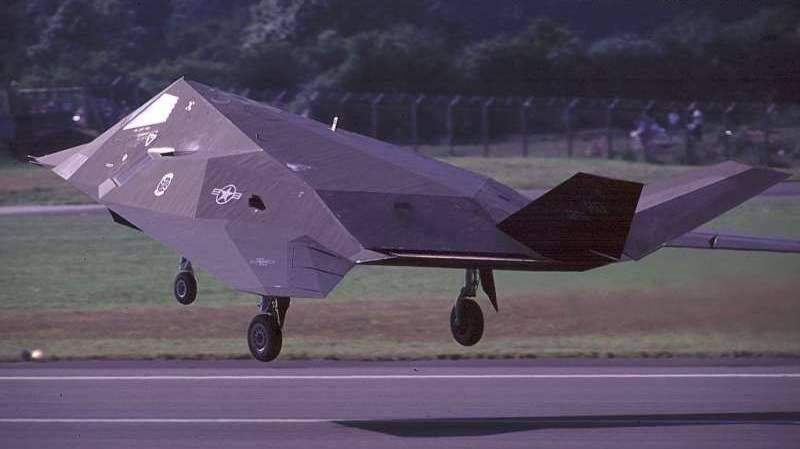
Departures for planned targets F-117A crews made every night. After two weeks of war, it became clear that the combat effectiveness of the Nighthawks was quite high. They began to send on the job more and more often. The load on the crews grew. To help exhausted pilots who made combat missions every night, on January 26, 6 stealth units, pilots, and some of the equipment from the 417th TFTS training squadron were transferred to Khamis Maschey. Thus, the total number of F-117A that participated in the conflict reached 42.
The arrival of reinforcements made it possible to somewhat reduce the load on the crews and materiel. Now the pilots took to the air every one and a half to two days, and still each of them eventually flew in combat conditions from 100 to 150 hours.
The thesis of the high efficiency of the F-117A in that war is considered indisputable. In particular, this is evidenced by the successful use of "stealth" to destroy strategic bridges in Iraq, whereas earlier they were used to make more than 100 unsuccessful sorties by F-15, F-16 and F / A-18 aircraft. Another example: four days before the start of the Allied land forces, seventeen F-117A struck the oil pipelines for 27 minutes, with which the Iraqis intended to fill the ditches in Kuwait with oil: 34 were hit by 32 targets. No less important result of the combat work of the “Nythokhok” was the destruction of the positions of the air defense missile system in Central Iraq, which enabled the crews of B-52 to carry out carpet bombing without hindrance. "Stealth" is attributed and the destruction of several Iraqi Tu-16, allegedly preparing to attack chemical munitions: In general, the F-117A war fulfilled 1271 flight lasting more than 7000 hours and dropped 2087 bombs, laser-guided GBU-10 and GBU-27 total mass of about 2000 tons. Their performance (relative number of combat missions with the defeat of the designated targets) was, according to official estimates, 80-95%. In particular, it is argued that the stealth pilots achieved 1669 direct hits, allowing only 418 misses. (Note that in the course of the Vietnam War, the average productivity was 33%, and by the beginning of the 1990s, 50% was the norm for ordinary types of airplanes.) But the most impressive is perhaps the statement that with only 2,5% of the total number of aircraft deployed in the Persian Gulf, F-117A hit about 40% of all strategic targets attacked by the allies.
Speaking later at a meeting in the United States Congress, commander of the Air Force of the multinational force in the Persian Gulf zone, General Lt.Gorner, stated on the basis of these data that unobtrusive aircraft, such as F-117A and B-2, would be indispensable in future local conflicts similar to the Gulf War.
Central to Horner’s speech was a comparison of two raids against heavily-defended Iraqi nuclear facilities in Al-Tuva, south of Baghdad. The first raid was carried out during the day in January 18, 32 it involved an aircraft F-16C, armed conventional unguided bombs, accompanied 16 fighter F-15C, four directors EF-111 interference antiradar eight F-4G and tankers COP 15-135. This large aviation group failed to complete the task. The second raid was carried out at night with just eight F-117A, each of which was armed with two GBU-27 bombs, accompanied by two tankers. This time, the Americans destroyed three of the four Iraqi nuclear reactors. According to Horner, the same damage could have been caused by two B-2 bomber during one sortie without attracting tankers.
However, we will not continue to quote here enthusiastic responses to the success of Naythok American generals, senators and other persons responsible for the processing of public opinion. Partly because there is other information about the effectiveness of the F-117A in Iraq. For example, some sources claim that out of several CABs, only one hit the target, and the real stealth performance did not exceed 30%. With the cost of one GBU-27 bomb in 175000 USD, this made the use of precision weapons very burdensome. According to official statistics, in the Persian Gulf, “smart” means of destruction accounted for less than 8% of all air munitions used by the allies, but their cost was 85% of the cost of all the missiles and bombs dropped on the enemy.
In addition, on the combat account of the F-117A (and at the same time on the conscience of its crews) there are several sad incidents. For example, the destruction of a bomb shelter in Baghdad on February 13, which was mistaken for a command post. As a result of this attack, more than 100 civilians were killed, which caused a great resonance in the world. Another interesting point: all sources of information controlled by the US Air Force unanimously claim that during the entire war not a single stealth was not only shot down, but even damaged by enemy fire. At the same time, there is information that one F-117A was shot down on January 20, 1991 by the Iraqi Igla MANPADS.
January 1991 of the year. A wonderfully publicized operation against Iraq - “Desert Storm. Indeed, on one night over the Arabian desert, not the newest (at that time) OCA air defense system from the first two-barreled salvo “shot” the F-117A stealth - the most “fashionable” aircraft invisible. By the way, there were rumors that the GRU reconnaissance group went to the crash site, which managed to pick up part of the electronics, samples of plating and glazing of the cabin.
The plane allegedly fell in the desert in Saudi Arabia, and Hussein’s subordinates simply did not have the opportunity to present his wreckage as evidence of their victory.
With the end of Operation Desert Storm, the success of F-117A has declined, although in this region the stealth fought periodically throughout the next decade. Thus, during the “punitive” operation against air defense facilities in southern Iraq (command posts, air defense missile systems, radar stations) held on 13 in January 1993, F-117A proved to be ineffective: six of these machines were able to hit only 2 targets from the 6 assigned. In two cases there was a breakdown of laser-guided bombs as they passed through the clouds, in the third the pilot was unable to detect the target, and in the fourth he incorrectly determined the turning point of the route and bombed the false target. This indicates the ability of the F-117A to perform operations only in simple weather conditions. And the described raid, in which, by the way, 38 of different types of aircraft took part, took place at night with poor visibility. It was the weather, according to representatives of the Pentagon, that caused the low impact of the raid: only 32 was hit by 16 planned targets. In December, X-NUMX F-1998A, working from bases in Kuwait, took part in Operation Desert Fox (Desert Fox) - the bombing of Iraqi factories producing weapons of mass destruction. During the 117 of the day, American aircraft performed 4 sorties against 650 targets, and the fleet launched the Tomahawks 100. However, the results of the operation almost nothing was reported, which can be interpreted as evidence of their absence. Sluggish war involving "stealth" in the so-called. The no-fly zone in southern Iraq is still ongoing (the article dates from 100 for the year - paralay).
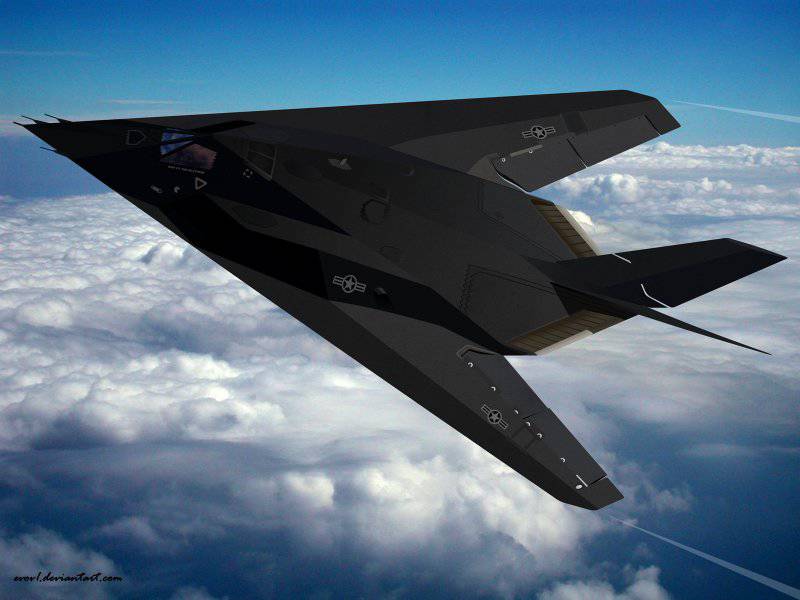
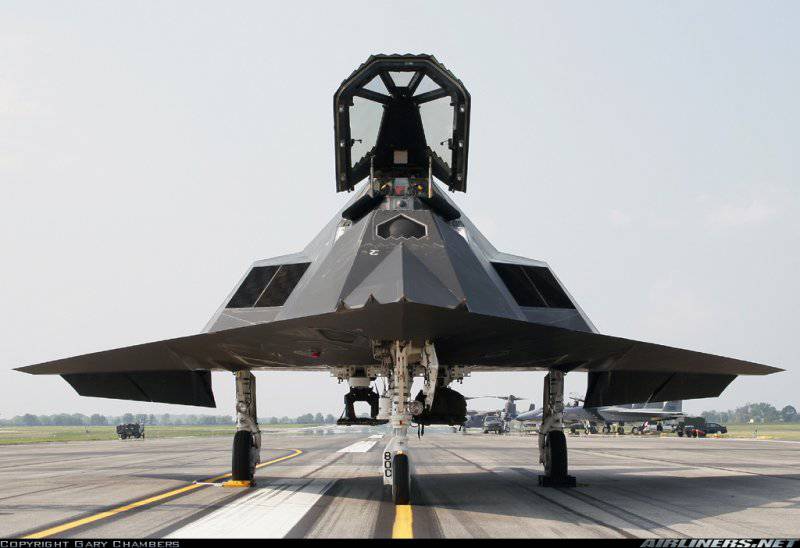
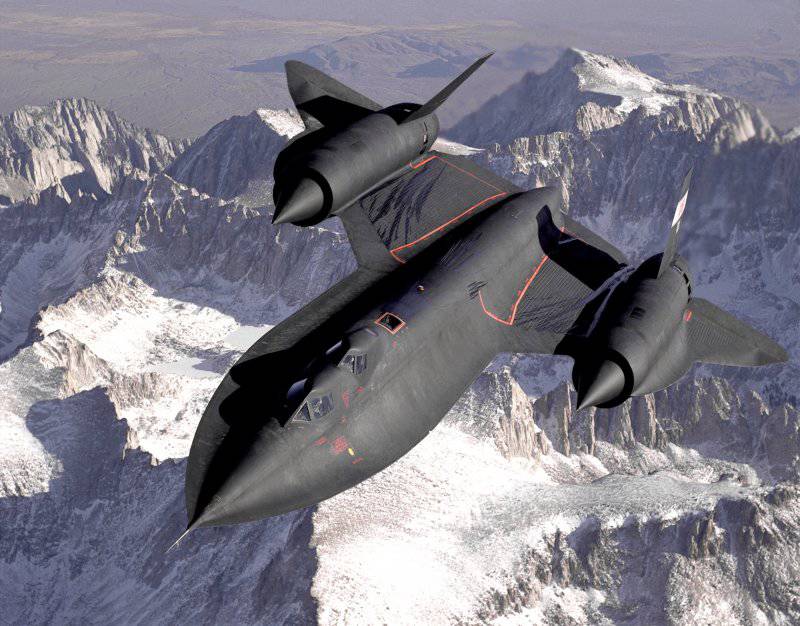
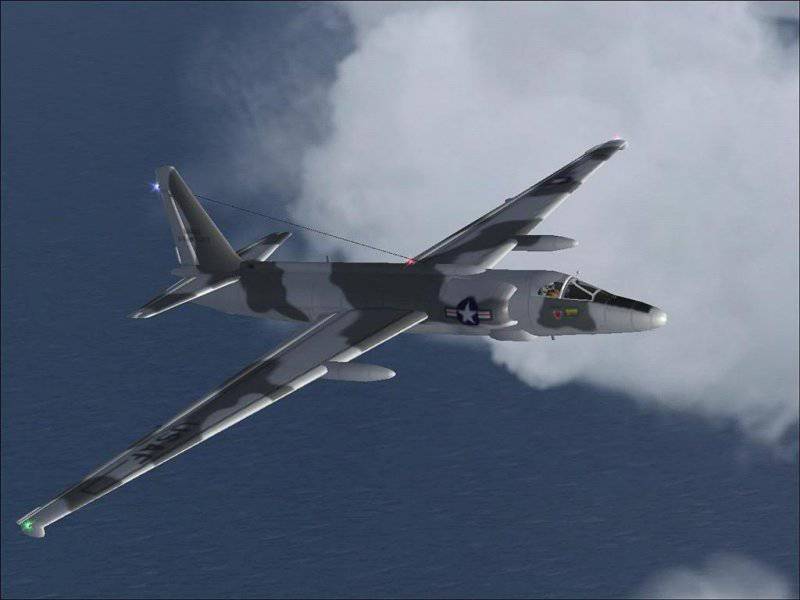

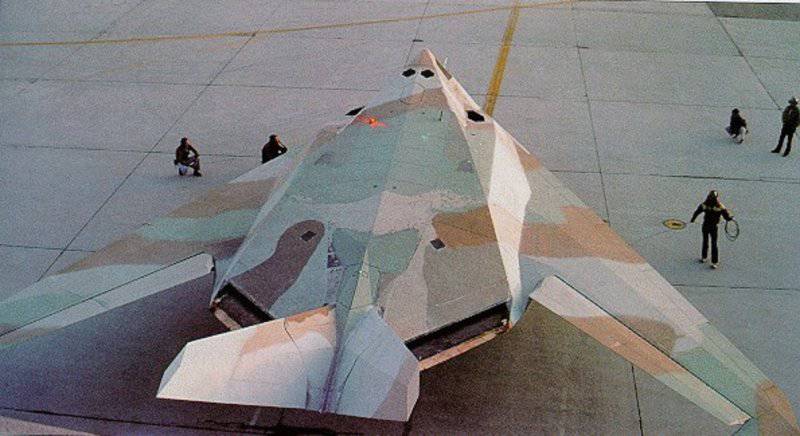
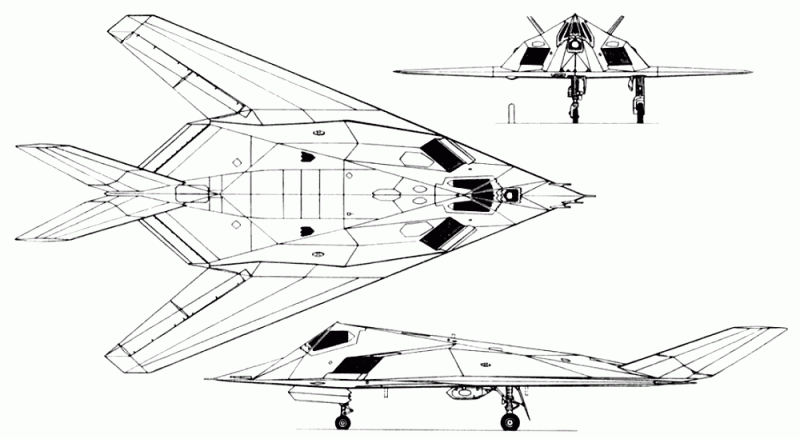
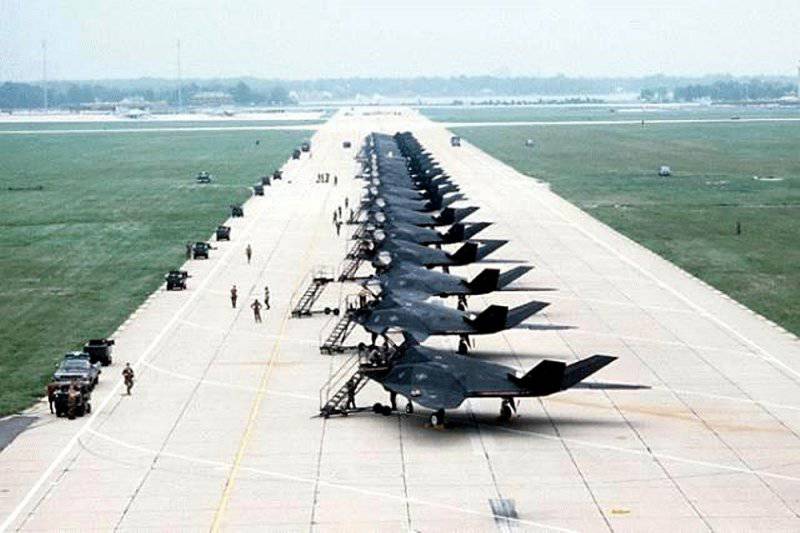
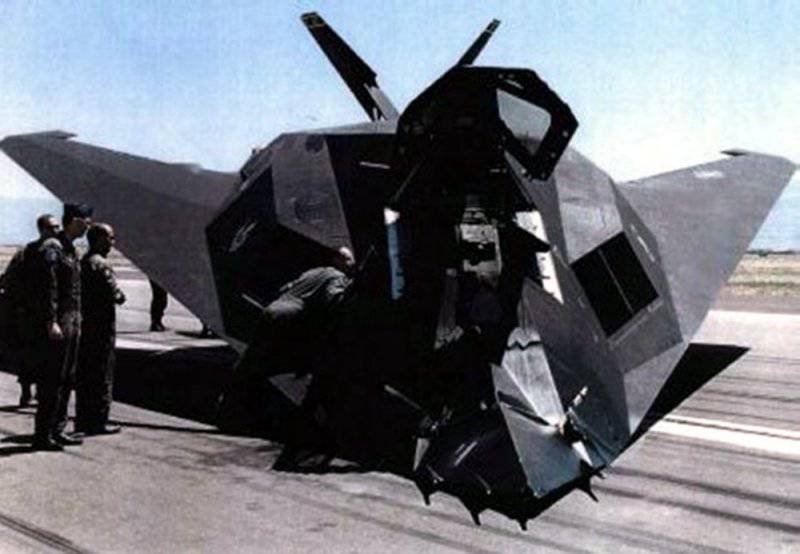
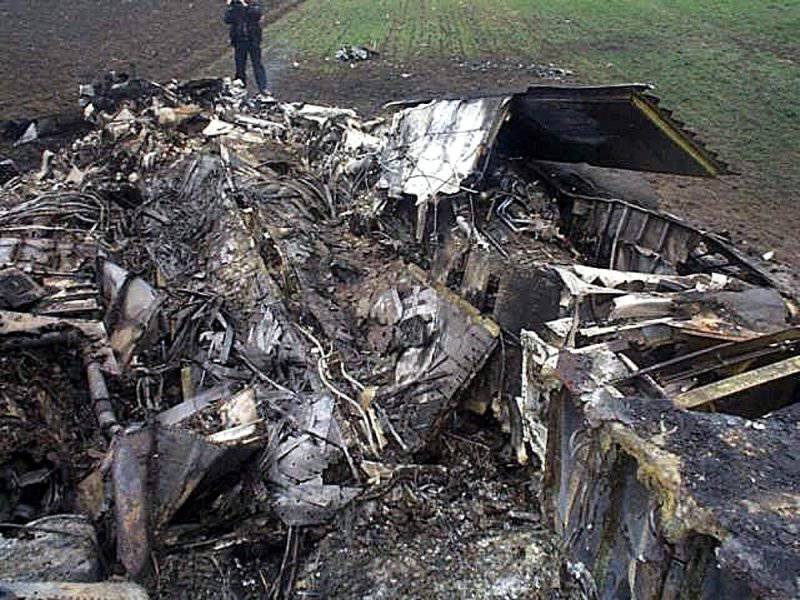
Information